
The Lord & Burnham Building, located at the corner of Main and Astor Streets in Irvington, New York, United States, is a brick building in the Queen Anne architectural style built in the 1880s. In 1999 it was listed on the National Register of Historic Places, and was added as a contributing property to the Irvington Historic District in 2014.

The Dorchester-Milton Lower Mills Industrial District is a historic district on both sides of the Neponset River in the Dorchester area of Boston and in the town of Milton, Massachusetts. It encompasses an industrial factory complex, most of which was historically associated with the Walter Baker & Company, the first major maker of chocolate products in the United States. The industrial buildings of the district were built between about 1868 and 1947. They were listed as part of the district on the National Register of Historic Places in 1980, with a slight enlargement in 2001. The buildings have been adapted for mixed industrial/retail/residential use.
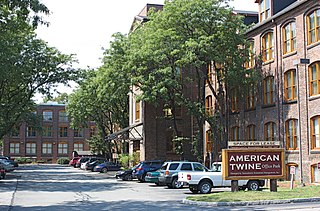
The American Net and Twine Company Factory is a historic factory at 155 2nd Street in Cambridge, Massachusetts. It was built in 1875 by the nation's first manufacturer of cotton fishing nets. It now houses corporate office space. It was listed on the National Register of Historic Places in 1982.

The Bigelow Carpet Company Woolen Mills are a historic mill complex on Main Street in Clinton, Massachusetts. The sprawling mill complex was built or expanded by the Bigelow Carpet Company, one of Clinton's leading business for much of the 19th and early 20th centuries. The complex was listed on the National Register of Historic Places in 1983. It continues to be adaptively reused by smaller businesses.
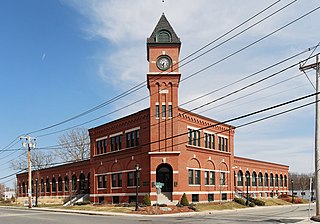
The H.F. Barrows Manufacturing Company Building, now the North Attleborough Police Station, is a historic industrial building in North Attleborough, Massachusetts. The elegant brick building was built in 1905–06, and was home for many years to one of the town's most successful jewelry businesses. It was listed on the National Register of Historic Places in 2001. Today the building serves as the headquarters for the North Attleborough Police Department.

The Old Weir Stove Company was an historic industrial facility located on West Water Street in Weir Village, Taunton, Massachusetts. The factory consisted of a series of connected brick buildings, located between West Water Street and the west bank of the Taunton River. The factory was built in 1902 and added to the National Register of Historic Places in 1984. It was later occupied by F.B. Rogers Silver Company. In May–June 2009, the site was demolished, except for the northernmost building of the complex.

Westfield Whip Manufacturing Company is a historic factory at 360 Elm Street in Westfield, Massachusetts. Built about 1887, it is the best preserved of Westfield's extant whip factory buildings. It is also home to the last surviving business of the many whipmakers that once operated in Westfield. The factory was listed on the National Register of Historic Places in 1985, and included in an expansion of the Westfield Center Historic District in 2013.

The H. M. Van Deusen Whip Company is an historic factory building at 42 Arnold Street in Westfield, Massachusetts, USA. Built in 1917, it is the last purpose-built whip factory to be built in Westfield, which was nationally known as "Whip City". The building, used until 1930 for whip production, was also somewhat retardaire in design, using late 19th-century construction methods. The building was listed on the National Register of Historic Places in 1987.

The American Waltham Watch Company Historic District encompasses the former factory of the Waltham Watch Company, the leading American watch manufacturer of the 19th century and the city's largest employer. Located on Crescent Street and the banks of the Charles River, the surviving elements of its manufacturing facility date from the 1870s to the 1910s, and include particularly fine industrial Romanesque architecture. The buildings have been converted to a variety of commercial, industrial and residential uses since they ceased being used for watchmaking in the 1950s. The complex was listed on the National Register of Historic Places in 1989.

The United States Watch Company is a historic factory complex at 260 Charles Street in Waltham, Massachusetts. Built in 1886 and enlarged in 1901, it represents one of the most successful spinoffs of the American Waltham Watch Company, Waltham's dominant watchmaker of the late 19th century. When the complex was listed on the National Register of Historic Places in 1989, it was the last watch factory left in the city.

The Worcester Bleach and Dye Works is a historic factory complex at 60 Fremont Street in Worcester, Massachusetts. It consists of a pair of primarily brick factory buildings, one of which was built in 1909, and the other built later, between 1911 and 1922, for the named company, which was a major local manufacturer of thread. After the Bleach and Dye Works closed its doors in 1938, the complex has seen a succession of other owners.

The Crompton Loom Works is an historic industrial complex of the Crompton Corporation at 132-142 Green Street in Worcester, Massachusetts. The factory manufactured looms for textile factories. With its original portion dating to 1860, the complex is one of the oldest surviving industrial sites in the city. The facility was established by George Crompton, whose father William had invented the first power loom for weaving fancy fabrics. The younger Crompton's business would become of the most significant employers in the city, and his innovative looms would revolutionize the textile industry. Crompton and his successors would operate the loom manufacturing works at Green Street well into the 1960s. The manufacturing capabilities on the site were applied to producing can packaging machines and bowling pinsetters. Capabilities at the Green Street facility included machining, drop hammer forging, a cast iron foundry, wood working. and pattern making, along with a materials testing lab.. The building has subsequently been adapted to other uses. The complex was listed on the National Register of Historic Places in 1980, and included as part of the Blackstone Canal Historic District in 1995.
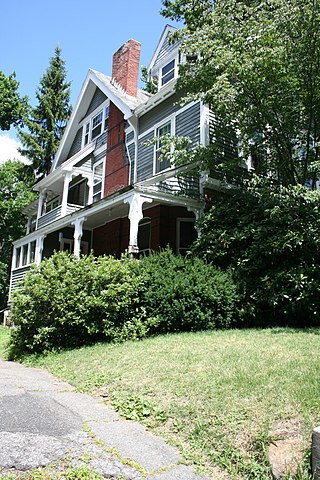
The Frederick Daniels House is a historic house at 148 Lincoln Street in Worcester, Massachusetts. Built about 1885, it is a well-preserved example of Queen Anne Victorian architecture, home to Frederick H. Daniels before he became president of Washburn and Moen, a leading Worcester industrial firm. It was listed on the National Register of Historic Places in 1980.

The Central Mills Historic District encompasses a historic mill complex on the Quinebaug River in central Southbridge, Massachusetts. Located at the corner of Foster and North Streets, the site consists of three brick buildings, the oldest of which has portions dating to 1837. Despite being extensively rebuilt in the early 20th century, the complex has an appearance that is more typical of 19th century mills.
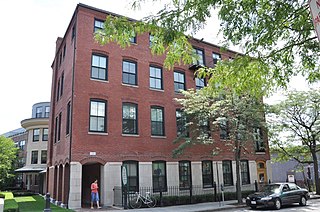
The Ritchie Building is a historic industrial building at 112 Cypress Street in Brookline, Massachusetts. Built in 1883 by Edward Samuel Ritchie, it is a fine example of the Panel Brick style, and is further notable as the factory space in which Ritchie manufactured a nationally distributed line of navigational instruments. The building was listed on the National Register of Historic Places in 1985.

The Union Mill Complex,, is located at the junction of Milton Avenue and Prospect Street in Ballston Spa, New York, United States. It is a complex of three late 19th-century brick buildings on a 4-acre lot, and the ruins of a dam.

The Madison Candy Company is a candy factory built in 1903 a half mile east of the capitol in Madison, Wisconsin. In 1997 it was added to the National Register of Historic Places.

The Orleans County Courthouse and Jail Complex is a historic government facility on Main Street in the city of Newport, Vermont, the shire town of Orleans County. The complex includes a fine Romanesque courthouse built in 1886, a wood-frame jailer's quarters built in 1886, and a 1903 brick jail. The complex was listed on the National Register of Historic Places in 1984.
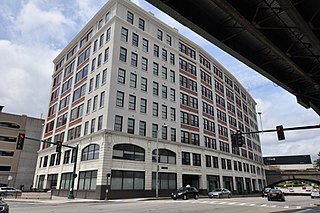
The Osgood Bradley Building is an historic industrial building at 18 Grafton Street in Worcester, Massachusetts. Completed in 1916, the eight-story brick building is notable for its association with the Osgood Bradley Car Company, an early manufacturer of both railroad cars and automobiles. The building was listed on the National Register of Historic Places in 2018.

The Commercial Exchange Building, also known as the Collins Manufacturing – Jackson Automobile Company complex, is an industrial building complex located at 2301 E. Michigan Ave. in Jackson, Michigan. The building was built partly in 1895, and was listed on the National Register of Historic Places in 1993. The listing included four contributing buildings.
























